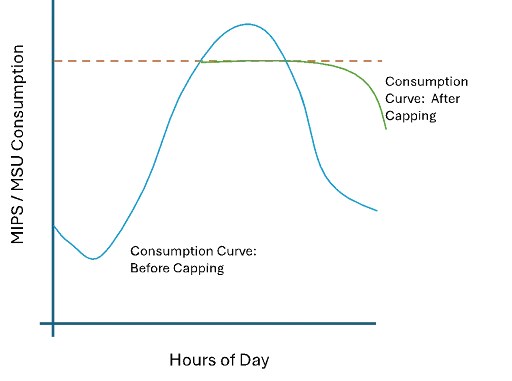The mainframe platform (IBM Z) remains a significant component of the contemporary IT enterprise, providing businesses with a reliable, secure and high-performance processing platform. However, these characteristics come with an associated cost: in a recent survey conducted by BMC, 49% of respondents indicated that cost optimization of their mainframe environment was one of their top priorities for the upcoming year. Since software expenses (i.e., licensing and maintenance) typically constitute the largest portion of a mainframe’s operating budget, focusing on this area is essential for driving cost efficiency. This article will explore some of the optimization strategies businesses can employ to manage their mainframe software spending effectively.
Mainframe software pricing factors
Before we talk about optimization strategies, we need to understand a bit more about the factors that influence your mainframe software bill each month. Please keep in mind that mainframe software licensing is an incredibly complex subject, so we will be simplifying this discussion considerably to keep the article accessible to a wider audience.
Vendor consolidation
Mergers and acquisitions have historically been employed as a business strategy to broaden market reach or achieve market dominance. This trend is notably observable in the mainframe software vendor ecosystem over recent years. The previously extensive and varied population of vendors has significantly diminished, with larger entities acquiring smaller ones. Consequently, vendor consolidation has substantially decreased customers' negotiating power, thereby shifting the balance in favor of vendors, who now effectively control software licensing terms and pricing for their customers.
MSU/MIPS consumption
One of the primary factors that influence mainframe software fees is the actual consumption of software required by your mainframe environment to process its workloads. Typically, this is quantified using Million Service Units (MSUs) or Millions of Instructions Per Second (MIPS). Simply put, these terms measure the computational capacity and speed of a particular mainframe system. Mainframe software vendors usually base their software fees on the MSU or MIPS ratings of a specific mainframe system, with higher MIPS/MSU figures generally leading to higher software fees.
Pricing models
In general, there are two key modes of licensing mainframe software, both based on the MSU / MIPS concepts described above:
- Full Capacity, where license fees are based on the total installed capacity of a mainframe server and
- Sub Capacity, where license fees are based on the actual consumption of MSUs / MIPS within the environment.
Example: An IBM z16 mainframe server model 3932-H06 is rated at 1,090 MIPS / 137 MSUs; this is the installed processing capacity of that particular mainframe model. Software licenses based on a Full Capacity model running in this environment would be charged on the 1,090 MIPS / 137 MSU amounts, regardless of the actual amount of processing that occurs within this environment. Whereas license fees using a Sub Capacity model would be based on the actual MIPS / MSUs consumed by the workloads…ideally some number below the maximum processing capacity of the mainframe server.
Another way to think about these models is to draw a comparison to how you pay your utility bills for your home:
Full Capacity Model = Internet bill, where you pay a fixed fee regardless of how much or how little data that is uploaded or downloaded.
Sub Capacity Model = Water or electricity bill, where you are charged on the actual amount of that resource that you consume over a period of time.
The Sub Capacity pricing model is considerably more intricate compared to the Full Capacity model. Each vendor supporting this method has distinct approaches for measuring MIPS / MSU consumption: some base their calculations on total aggregate consumption, while others determine fees based on monthly peak consumption. Although managing this inherent complexity can be challenging, it provides businesses with opportunities to implement strategies aimed at reducing their consumption and thereby lowering software license fees.
Managing mainframe software costs
There are numerous strategies that mainframe consumers can utilize to optimize their software expenditure, some of which will be briefly discussed in this article. Due to the complexity of mainframe software licensing, it is advisable to engage highly skilled and experienced experts to evaluate your situation and implement an optimization strategy.
Workload management
One method to optimize an enterprise’s mainframe software expenditure involves managing the workloads executed within the environment. By "flattening" the mainframe's MIPS / MSU consumption curve, benefits can be gained for Sub Capacity pricing models, which are typically based on monthly peak consumption. The mainframe operating system includes a feature called “Soft Capping,” which allows system programmers to set a limit on the maximum MIPS / MSUs consumed during a billing interval. While this can reduce Sub Capacity software costs, it may also delay the execution of mainframe workloads, potentially affecting service levels. Therefore, this strategy is usually implemented alongside an analysis to reschedule less critical mainframe workloads outside of peak consumption periods.

Economies of scale
In general, the more of an object you purchase, the less it costs per unit; this principle holds true within the mainframe world as well. Businesses operating small to mid-size mainframe environments are at a disadvantage in terms of purchasing scale because they only need to purchase the amount of MIPS/MSUs that their business requires. This “right sized” purchasing quantity often comes at a higher per unit price. These businesses may benefit from engaging a mainframe service provider that can offer a “Mainframe as a Service” solution.
Mainframe service providers purchase licenses in bulk, sign long-term contracts and have special access privileges, which would be too costly for smaller mainframe customers to obtain on their own. By aggregating the many clients they are purchasing software for, the service provider can leverage this purchasing scale with mainframe equipment vendors to offer the necessary resources to smaller mainframe clients at a lower cost while still making a profit. This creates a mutually beneficial situation for all parties involved.
Software rationalization
It goes without saying that mature software asset management practices are imperative to a well-run IT shop. Without keeping a strict tab on the purchase, deployment, utilization, maintenance and disposal of applications that run on a mainframe, cost control is nearly impossible.
Conducting periodic technical audits of your mainframe environment will help identify applications and OEM software products that are redundant and therefore no longer required. These should be cleaned out of the system and removed from the licensing agreements with the relevant vendors.
A more extreme component of a software rationalization program includes the evaluation of the utilized software products from a particular OEM, with the intention of replacing the entire product suite with those of a competitor. These projects are generally complex and require highly specialized skilled resources, but can yield very significant cost savings.
Building synergies with the best in business
HCLTech has demonstrated expertise in providing end-to-end services for mainframe environments. Our consulting, hosting, operations and transformation services encompass every aspect of mainframe migration, optimization and foundation that modern enterprises need. Strategic partnerships with vendors such as IBM give us a unique advantage to have a comprehensive portfolio of mainframe solutions, including software ecosystem evaluation, optimization and competitive replacement.
Our capabilities are evident from our diverse clientele, comprising several Fortune 500 names and the successful services we have been delivering to them.
Closing note
Despite its age, the mainframe has stood the test of time and proven that it’s not going anywhere anytime soon. So, when it comes to mainframe cost optimization, enterprises need to have a proactive posture. Managing the expenditure cannot be an afterthought but an integral part of the mainframe lifecycle strategy. By considering the abovementioned factors and techniques and seeking expert assistance, organizations can minimize their mainframe expenditure and maximize the value they derive from it.


